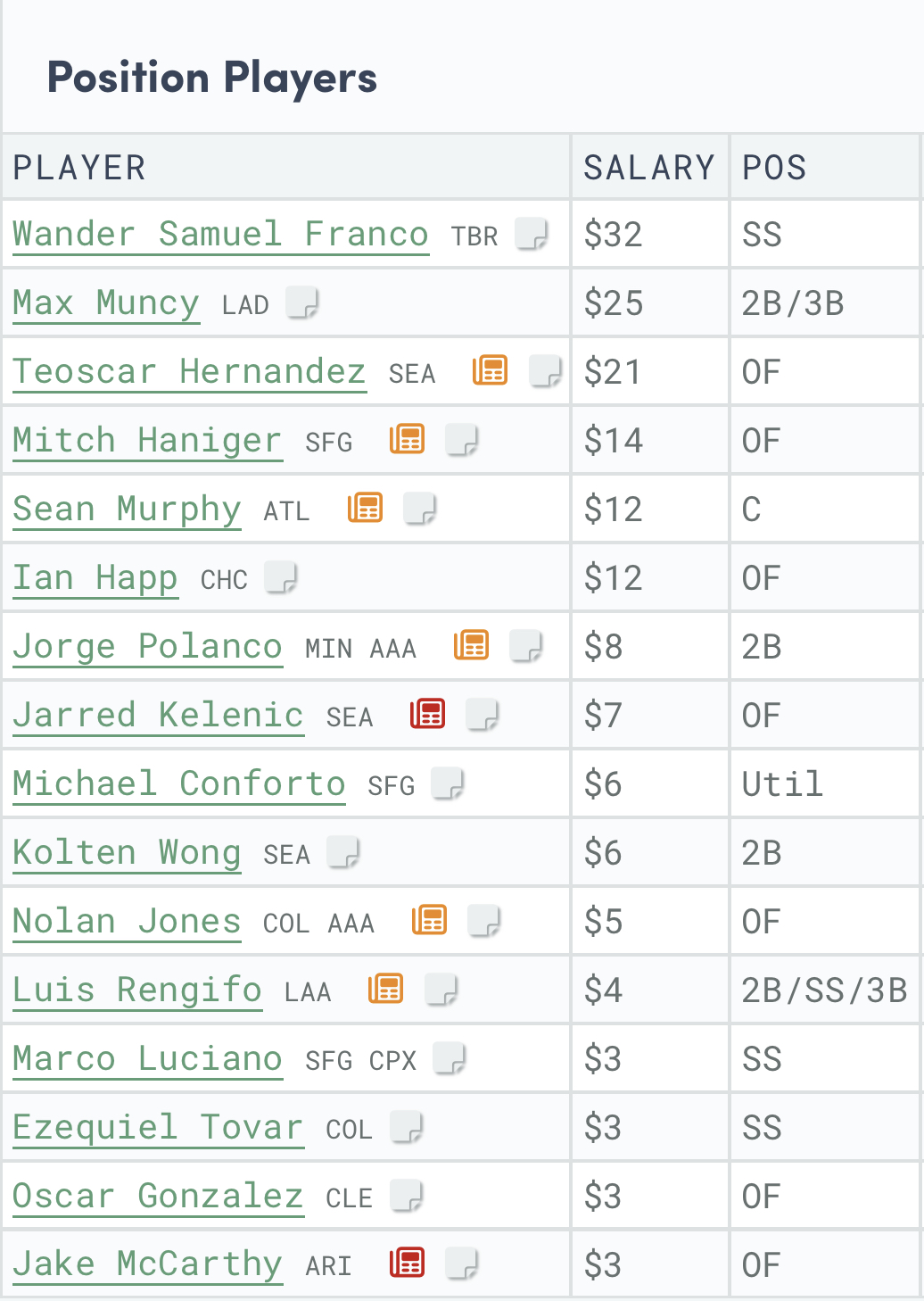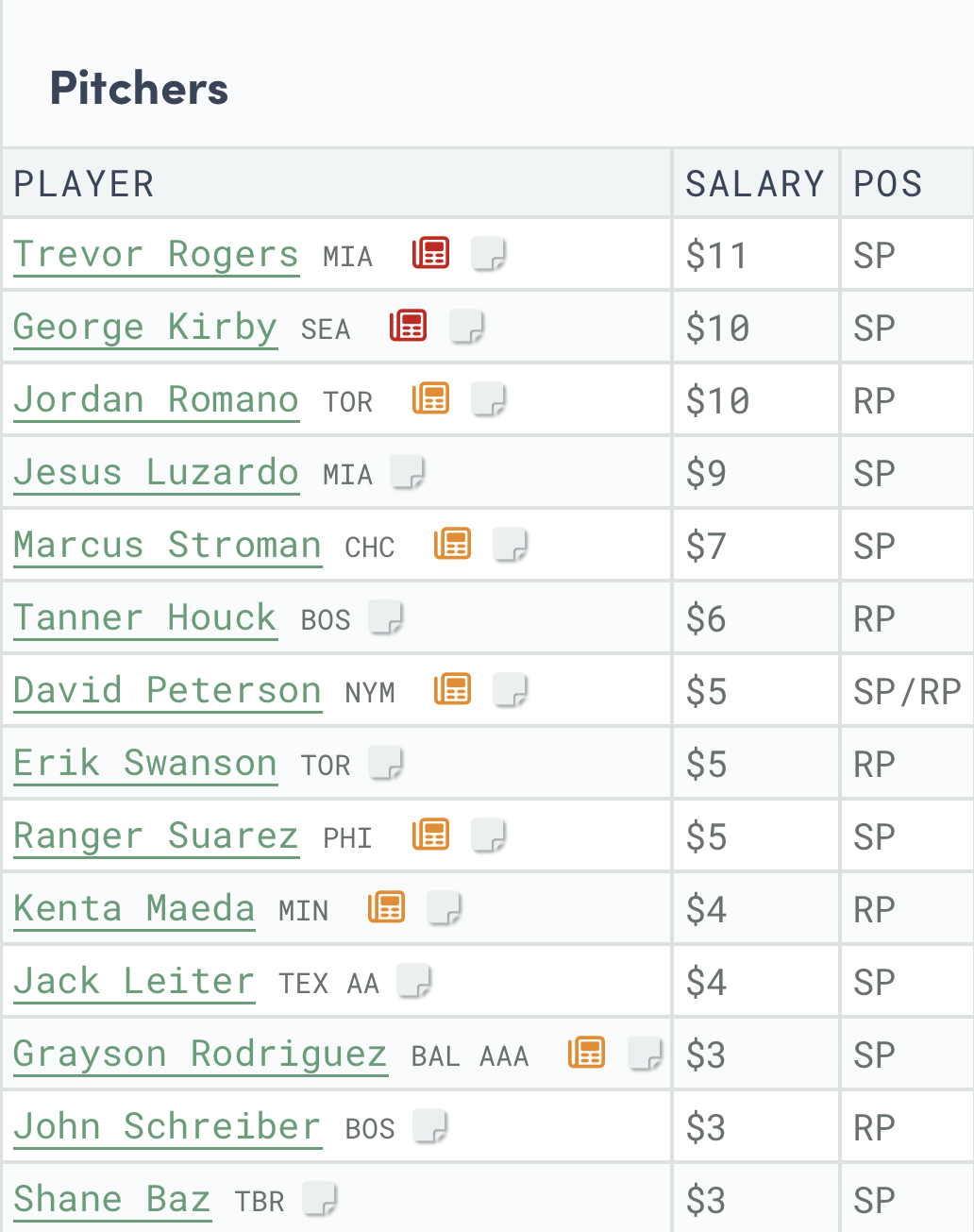Ottoneu Auction Draft Values Up and Down
Draft season is almost over and the regular season is just over the horizon. I’m sure there are a few leagues drafting at the last possible moment before Opening Day on Thursday, but I figured we could do a little auction analysis to see which players have gained or lost value during the preseason.
First, I pulled some data on players auctioned since February 1 in all FG points leagues. Then I pulled some data from the Average Salaries page to use as a baseline. Obviously, the average salary listed on that page will include players auctioned during this draft season, so it’s not a perfect comparison, but it’ll do. I’ve also compared the 2023 auction data against the listed “Last 10” value from the Average Salaries page to give a sense of how auction values have changed recently. The tables below will show the top 10 value gainers and losers for both of those measures.
Value up
| Name | 2023 Auctions | Average 2023 Auction Value | Overall Average Salary | Difference |
|---|---|---|---|---|
| Julio Rodríguez | 37 | $49.54 | $24.99 | $24.55 |
| Spencer Strider | 34 | $33.15 | $15.32 | $17.83 |
| Michael Harris II | 27 | $26.04 | $10.68 | $15.36 |
| Corbin Carroll | 25 | $22.80 | $7.70 | $15.10 |
| Shohei Ohtani | 31 | $68.45 | $53.59 | $14.86 |
| Shane McClanahan | 31 | $31.81 | $17.66 | $14.15 |
| Justin Verlander | 28 | $26.04 | $13.43 | $12.61 |
| Bobby Witt Jr. | 34 | $29.15 | $16.64 | $12.51 |
| Kyle Tucker | 32 | $43.38 | $31.06 | $12.32 |
| Yordan Alvarez | 30 | $51.13 | $38.86 | $12.27 |
This list is mostly populated with youngsters who were likely kept at very reasonable values but auctioned closer to their true talent level. For the most part, the average values from this draft season fall pretty close to where I had ranked them earlier this offseason; The outliers are Julio Rodríguez and Bobby Witt Jr. Rodríguez’s helium makes sense after a phenomenal rookie campaign and an offseason where he’s been positioned as the face of the future of baseball. I picked him up in a first-year league for $45 this year, which now seems like a bargain considering where his average value lies.
Witt’s rise in value is a little tougher to parse. He didn’t have as sterling a rookie year as Rodríguez, but the talent is undeniable. I ranked him in the $15-$19 tier but he’s being auctioned closer in value to Marcus Semien, Wander Franco, and Xander Bogaerts. The projections see him improving over his 99 wRC+ he posted in 2022, but not to the level of those other three. His positional versatility probably helps boost his value a tiny bit, but I’m not sure I’d be comfortable paying more than $20 for him right now.
| Name | 2023 Auctions | Average 2023 Auction Value | Last 10 | Difference |
|---|---|---|---|---|
| Shohei Ohtani | 31 | $68.45 | $77.20 | $8.75 |
| Bryan Reynolds | 31 | $24.87 | $30.40 | $5.53 |
| Sandy Alcantara | 33 | $35.88 | $41.40 | $5.52 |
| Luis Castillo | 32 | $27.34 | $32.50 | $5.16 |
| Steven Kwan | 30 | $13.07 | $18.20 | $5.13 |
| Taylor Ward | 32 | $15.97 | $20.60 | $4.63 |
| Matt Olson | 36 | $30.31 | $34.60 | $4.29 |
| Spencer Strider | 34 | $33.15 | $37.40 | $4.25 |
| Sean Murphy | 33 | $11.24 | $15.40 | $4.16 |
| Yordan Alvarez | 30 | $51.13 | $55.00 | $3.87 |
More recently, we’ve seen some spring standouts gain value with WBC MVP and all-world superstar Shohei Ohtani seeing the biggest leap. And with good reason too. With the change in how Ottoneu handles two-way players this season, managers will be able to earn both hitting and pitching points on days where the player is accumulating both. Ohtani was already incredibly valuable in this format and this adjustment will only help managers squeeze every single point out of his two-way eligibility.
Another spring standout who has seen a recent rise in value is Matt Olson. He launched his eighth spring training home run on Monday and looks poised to have a monster season. He struggled a bit during his first year in Atlanta, suffering through a 35 point drop in wOBA fueled by deteriorating plate discipline metrics. If he’s able to get his strikeout and walk rates back in line with where they were during his 2021 breakout while also benefiting from the shift ban, he should be able to blow past his current value.
Kwan is another interesting riser. I wrote about the risks associated with him in my outfield rankings article, but the TL;DR version is that he’s overly reliant on good outcomes on all of his batted balls to truly be an elite points league accumulator. Just look at what happened during his first two months in the league where he posted a .259 BABIP and a 105 wRC+. An $18 salary puts him around guys like Cedric Mullins, Nick Castellanos, and Taylor Ward, all of whom I view as having a higher ceiling due to their potential power output.
Value down
| Name | 2023 Auctions | Average 2023 Auction Value | Overall Average Salary | Difference |
|---|---|---|---|---|
| Edwin Díaz | 41 | $11.90 | $18.01 | -$6.11 |
| Lance McCullers Jr. | 90 | $6.01 | $10.23 | -$4.22 |
| Gavin Lux | 104 | $2.87 | $6.47 | -$3.60 |
| Brendan Rodgers | 75 | $3.09 | $6.48 | -$3.39 |
| Xander Bogaerts | 183 | $28.92 | $32.15 | -$3.23 |
| Jacob deGrom | 113 | $40.61 | $43.47 | -$2.86 |
| Bryce Harper | 260 | $34.09 | $36.85 | -$2.76 |
| Max Scherzer | 120 | $36.14 | $38.88 | -$2.74 |
| Matt Manning | 71 | $1.94 | $4.63 | -$2.69 |
| Gerrit Cole | 141 | $42.44 | $44.95 | -$2.51 |
The list of players whose values have fallen is unsurprisingly headlined by a bunch of injured players or players with significant injury risk. The surprise here is Xander Bogaerts. I wrote about why I like him more than the market in my shortstop rankings article and my thoughts haven’t changed. He’s been extremely consistent over the last five years and has a fantastic lineup surrounding him in his new home in San Diego. I get that there’s a bit of concern with both his barrel and hard hit rates falling last year, but I’m betting he’ll be just fine. Bogaerts was auctioned for just $17 in the FanGraphs Staff League and I’m confident that’s going to look like a steal by the end of this season.
| Name | 2023 Auctions | Average 2023 Auction Value | Last 10 | Difference |
|---|---|---|---|---|
| Jose Altuve | 43 | $28.74 | $19.70 | -$9.04 |
| Rhys Hoskins | 70 | $17.00 | $8.20 | -$8.80 |
| Raisel Iglesias | 107 | $15.59 | $10.00 | -$5.59 |
| Jorge Polanco | 95 | $10.78 | $7.00 | -$3.78 |
| Clayton Kershaw | 105 | $19.48 | $15.90 | -$3.58 |
| Starling Marte | 167 | $20.26 | $16.70 | -$3.56 |
| Vaughn Grissom | 61 | $12.66 | $9.10 | -$3.56 |
| Edwin Díaz | 41 | $11.90 | $8.60 | -$3.30 |
| Luis Severino | 46 | $15.93 | $12.70 | -$3.23 |
| Yu Darvish | 71 | $24.51 | $21.40 | -$3.11 |
Again, the list of recent value losers is populated with guys who have picked up spring injuries. Altuve, Hoskins, Iglesias, Polanco, Díaz, and Severino are all on track to start the season on the Injured List and two of those guys were lost for the season. The drops for Kershaw and Darvish appear to be connected to age-related risk; the former looks healthy and ready for another strong season and the latter was slow to ramp up due to the WBC, but looks poised to join the Padres rotation as the fourth or fifth starter.
I can’t really figure out the drop for Starling Marte. He’s enjoyed a solid spring, with a .344/.361/.563 slash line in 36 plate appearances. Over the last two years, he’s posted a 135 wRC+ with solid peripherals. He did post his highest strikeout rate since 2016 last year and his barrel rate didn’t exactly support his .176 ISO, so I suppose there’s a bit of concern there. Still, his recent average salary feels like a pretty decent bargain on an excellent veteran contributor.


